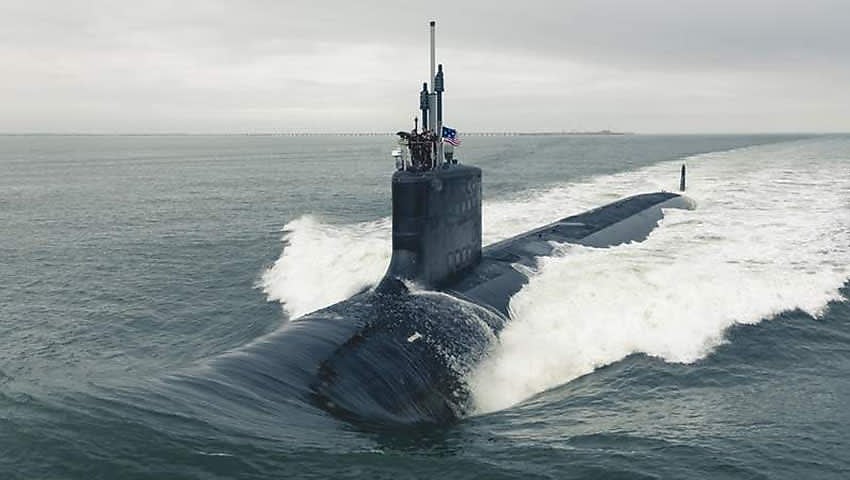Prime Minister Anthony Albanese, Deputy Prime Minister and Defence Minister Richard Marles, and Defence Industry Minister Pat Conroy have revealed the government’s plan to develop the Australian workforce and industrial base to help deliver the nation’s future nuclear-powered submarines.
The wait is finally over, with Prime Minister Anthony Albanese, UK Prime Minister Rishi Sunak, and US President Joe Biden revealing the fruits of the trilateral AUKUS partnership with Australia’s optimal pathway to fielding a world-leading, nuclear-powered submarine fleet, to be known as the SSN-AUKUS, at least for the time being.
The Australian government recognises the central role a local industrial base and world-leading workforce will play in shaping the cost-effective and on schedule delivery of these future platforms, announcing they are developing a comprehensive AUKUS submarine workforce and industry strategy to support delivery of advanced conventionally armed, nuclear-powered submarines to the Australian Defence Force.
The AUKUS submarine program has been described as “the most transformative industrial endeavour in Australian history” — exceeding in scale, complexity, and economic significance the creation of an Australian automotive manufacturing sector and the construction of the Snowy Scheme in the post-war decades.
Australia’s industrial base will be just the second in history to be granted access to highly sensitive US nuclear propulsion capability and afforded the ability to access, handle, build, and sustain this sensitive technology.
Australians have already commenced training and working on UK and US nuclear-powered submarines in UK and US facilities. The government expects that between 2027 to 2032, an additional 500 direct jobs are expected to be created to sustain the Submarine Rotational Force-West US and UK presence in Western Australia.
This will mean Australia has a trained and experienced sovereign workforce for the arrival of Australia’s Virginia Class submarines from as soon as the early 2030s — at its peak, up to an estimated 4,000 Australian workers will be employed to design and build the infrastructure for the new submarine construction yard in South Australia.
The Australian government explained that a further 4,000 to 5,500 direct jobs will be created to build the nuclear-powered submarines in South Australia when the program reaches its peak in 20 to 30 years, almost double the workforce the former government forecast for the Attack Class program.
As part of developing the AUKUS submarine workforce and industry strategy, the government expects the strategy will detail how Australia will:
- Attract, recruit, develop, qualify and retain a highly skilled trades, technical, scientific and engineering workforce;
- Invest in new infrastructure for sustaining and building nuclear-powered submarines in Australia; and
- Support and build the capabilities of Australia’s world-leading defence industry.
Key elements of the strategy the government is planning include:
Infrastructure
The new fleet of submarines will require extensive new sustainment infrastructure in Western Australia at HMAS Stirling including wharf upgrades, warehousing, and sustainment facilities.
These facilities will be supported by new submarine construction infrastructure in South Australia at the Osborne shipbuilding precinct, including site identification and design, land transfer discussions, civil works and prototype facilities, and national engineering and technology facilities as part of the whole-of-nation strategy to develop the world-leading workforce required to support the delivery, operation, and sustainment of the nation’s nuclear-powered submarine fleet.
Workforce
The government’s strategy will place a heavy emphasis on building the workforce necessary. The government’s strategy will conduct detailed workforce planning to include identifying the Australian submarine industrial workforce through forecasting workforce demand and supply, identifying priority skills areas, identifying education and training requirements, and finalising a workforce strategy.
The Commonwealth will also work with the South Australian government on a dedicated Skills and Training Academy to deliver tailored education, training and skilling for Australia’s submarine and naval shipbuilding workforce including:
- Career training programs to bring new people into the workforce, such as apprentices, undergraduates, and graduate apprentices;
- Lifting the skills of the existing naval shipbuilding workforce; and
- Transition programs to bring in people from adjacent industries in the defence, manufacturing and technology sectors.
This work will be expanded to include workforce training and development in Western Australia, to develop a skills and training program, leveraging existing relationships with WA vocational and tertiary institutions — this will also include early opportunities to embed industrial, Australian Defence Force, and Australian Public Service personnel in UK and US facilities and shipyards to build the necessary skills and experience on active submarine construction lines.
Finally, the workforce development strategy will also include a suite of new education and training courses including:
- Expanding the Sovereign Shipbuilding Talent Pool (SSTP), commencing with an initial cohort of 74 apprentices, undergraduates, and graduates in coming months;
- Developing nationwide education and skilling plans with the university and vocational education sectors; and
- Supporting an existing cohort of over 50 Australians to commence new specialised courses in the UK and US and new tertiary courses for nuclear engineering at the University of New South Wales and nuclear science at the Australian National University.
Industrial base
Having the necessary industrial base in the country will prove equally critical to operating and sustaining, not just Australia’s own fleet of nuclear-powered submarines, but also supporting those of the US and Royal Navy’s, respectively, accordingly, the government’s strategy will:
- Develop opportunities for Australian industry to carry out maintenance for US Virginia Class and UK Astute Class submarines during their rotational presence in Western Australia;
- Provide opportunities to embed Australian industry in the UK and US nuclear-powered submarine construction and sustainment programs and supply chains with our partners, including Australian industry supplying Australian-manufactured materials and components to the UK and US submarine programs; and
- Establish mechanisms for Australian industry to register interest in participating in the Australian, UK and US nuclear-powered submarine programs.
The government states, “The AUKUS submarine workforce and industry strategy will be finalised and implemented in consultation with our trilateral partners and state and territory governments, industry and unions.”








